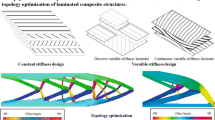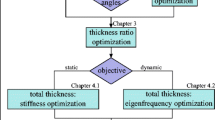Abstract
In this work optimum stiffness design of laminated composite structures is performed using the commercially available programs ANSYS and MATLAB. Within these programs a Free Material Optimization algorithm is implemented based on an optimality condition and a heuristic update scheme. The heuristic update scheme is needed because commercially available finite element analysis software is used. When using a commercial finite element analysis code it is not straight forward to implement a computationally efficient gradient based optimization algorithm. Examples considered in this work are a clamped-clamped 2D plate loaded in two load cases and a point loaded six layered 3D double curved corner hinged shell. The first example displays the effect of varying the size of patches having the same parametrization, and the second illustrates the benefit of using a layered free material parametrization. The results provide information concerning topology, material anisotropy, and the direction having the maximum stiffness. The obtained results are compared to gradient based optimization solutions using Discrete Material Optimization and Continuous Fiber Angle Optimization implemented in a research code, where full access to the finite element analysis core is granted. This comparison displays the possibility of using commercially available programs for stiffness design of laminated composite structures.





















Similar content being viewed by others
References
Abrate S (1994) Optimal design of laminated plates and shells. Compos Struct 29(3):269–286
Altair (2013) Altair OptiStruct. http://www.altairhyperworks.com/
ANSYS Inc (2013a) ANSYS Release 14.0 Documentation
ANSYS Inc (2013b) ANSYS web page., http://ansys.com/
Arora J, Wang Q (2005) Review of formulations for structural and mechanical system optimization. Struct Multidiscip Optim 30(4):251–272
Bendsøe M, Sigmund O (2003) Topology optimization: theory, methods and applications, 2nd edn. Springer-Verlag, Berlin
Bendsøe MP, Guedes JM, Haber RB, Pedersen P, Taylor JE (1994) An analytical model to predict optimal material properties in the context of optimal structural design. J Appl Mech 61(4):930–937
Bendsøe MP, Di̇az AR, Lipton R, Taylor JE (1995) Optimal design of material properties and material distribution for multiple loading conditions. Int J Numer Methods Eng 38(7):1149–1170
Bendsøe MP, Guedes JM, Plaxton S, Taylor JE (1996) Optimization of structure and material properties for solids composed of softening material. Int J Solids Struct 33(12):1799–1813
Bloomfield MW, Herencia JE, Weaver PM (2010) Analysis and benchmarking of meta-heuristic techniques for lay-up optimization. Comput Struct 88(5–6):272–282
Bruyneel M (2011) SFP-a new parameterization based on shape functions for optimal material selection: application to conventional composite plies. Struct Multidiscip Optim 43(1):17–27
Bruyneel M, Fleury C (2002) Composite structures optimization using sequential convex programming. Adv Eng Softw 33(7–10):697–711
Cheng G, Pedersen P (1997) On sufficiency conditions for optimal design based on extremum principles of mechanics. J Mech Phys Solids 45(1):135–150
Chin CM, Fletcher R (2003) On the global convergence of an SLP-filter algorithm that takes EQP steps. Math Programm 96(1):161–177
Dassault Systèmes (2013) Abaqus Unified FEA. http://www.3ds.com/products-services/simulia/portfolio/abaqus/overview/
Gao T, Zhang W, Duysinx P (2012) A bi-value coding parameterization scheme for the discrete optimal orientation design of the composite laminate. Int J Numer Methods Eng 91(1):98–114
Ghiasi H, Pasini D, Lessard L (2009) Optimum stacking sequence design of composite materials Part I: constant stiffness design. Compos Struct 90(1):1–11
Ghiasi H, Fayazbakhsh K, Pasini D, Lessard L (2010) Optimum stacking sequence design of composite materials Part II: variable stiffness design. Compos Struct 93(1):1–13
Hörnlein H, Kočvara M, Werner R (2001) Material optimization: bridging the gap between conceptual and preliminary design. Aerosp Sci Technol 5(8):541–554
Hvejsel C, Lund E (2011) Material interpolation schemes for unified topology and multi-material optimization. Struct Multidiscip Optim 43(6):811–825
Hvejsel CF, Lund E, Stolpe M (2011) Optimization strategies for discrete multi-material stiffness optimization. Struct Multidiscip Optim 44(2):149–163
Jones RM (1999) Mechanics of composite materials, 2nd edn. Materials Science and Engineering Series. Taylor & Francis Group
Kim TS, Kim YY (2000) Mac-based mode-tracking in structural topology optimization. Comput Struct 74(3):375–383
Kočvara M, Stingl M, Zowe J (2008) Free material optimization: recent progress. Optimization 57(1):79–100
Lund E, Stegmann J (2005) On structural optimization of composite shell structures using a discrete constitutive parametrization. Wind Energy 8(1):109–124
MUST (2014) The MUltidisciplinary Synthesis Tool. Department of Mechanical and Manufacturing Engineering, Aalborg University, http://www.must.m-tech.aau.dk/
Pedersen NL (2006) On design of fiber-nets and orientation for eigenfrequency optimization of plates. Comput Mech 39(1):1–13
Pedersen P (1989) On optimal orientation of orthotropic materials. Struct Optim 1(2):101–106
Pedersen P (1990) Bounds on elastic energy in solids of orthotropic materials. Struct Optim 2(1):55–63
Pedersen P, Pedersen NL (2013) On strength design using free material subjected to multiple load cases. Struct Multidiscip Optim 47(1):7–17
PLATO-N (2013) A platform for topology optimisation incorporating, novel large-scale, free-material optimisation and mixed integer programming methods. http://www.plato-n.org/
Prager W, Taylor J (1967) Problems of optimal structural design. J Appl Mech 35:102–106
Ringertz U (1993) On finding the optimal distribution of material properties. Struct Optimization 5(4):265–267
Sigmund O, Torquato R (1997) Design of materials with extreme thermal expansion using a three-phase topology optimization method. J Mech Phys Solids 45(6):1037–1067
Stegmann J, Lund E (2005) Discrete material optimization of general composite shell structures. Int J Numer Methods Eng 62(14):2009–2027
Thomsen J, Olhoff N (1990) Optimization of fiber orientation and concentration in composites. Control Cypernetics 19(3–4):321–341
Zhou M, Fleury R (2012) Composite optimization – Ply drop-rate constraints for concept and detailed design. In: Proceeding of the 23rd international congress of theoretical and applied mechanics (ICTAM). Beijing, China
Zhou M, Fleury R, Kemp M (2011) Optimization of composite - recent advances and application.. In: Proceeding of the 7th altair CAE technology conference. Warwickshire, United Kingdom
Acknowledgments
This research is sponsored by The Danish National Advanced Technology Foundation (DNATF) Grant no. 107-2012-2. This support is gratefully acknowledged.
Author information
Authors and Affiliations
Corresponding author
Rights and permissions
About this article
Cite this article
Henrichsen, S.R., Lindgaard, E. & Lund, E. Free material stiffness design of laminated composite structures using commercial finite element analysis codes. Struct Multidisc Optim 51, 1097–1111 (2015). https://doi.org/10.1007/s00158-014-1199-3
Received:
Revised:
Accepted:
Published:
Issue Date:
DOI: https://doi.org/10.1007/s00158-014-1199-3




